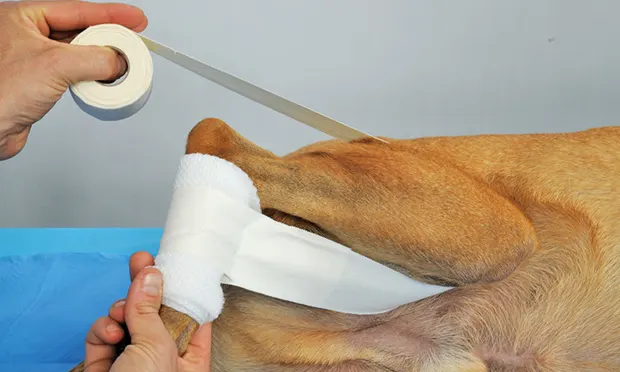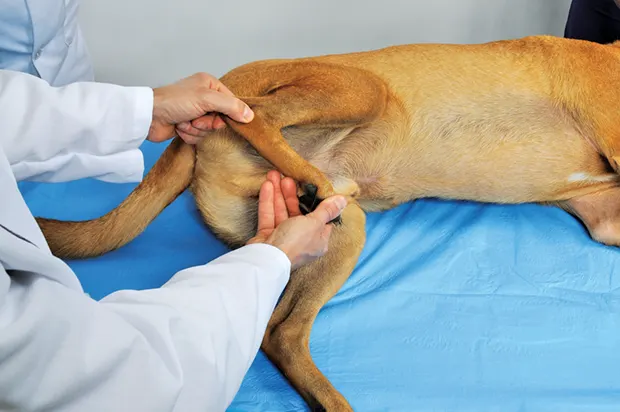The Ehmer Sling in Canine Orthopedic Surgery
Walter C. Renberg, DVM, MS, DACVS, Kansas State University
James K. Roush, DVM, MS, DACVS, Kansas State University

Case Selection & Management
Proper case selection for Ehmer or Figure-8 sling use is critical to a successful outcome. The Ehmer sling was designed to maintain the head of the femur in the acetabulum after closed reduction of a craniodorsal coxofemoral luxation, to prevent weight bearing, and to limit hip motion during healing. It should not be used in dogs with ventral coxofemoral luxation, which should be treated with hobbles to prevent limb abduction.
Best results are obtained in dogs with acute luxations <24 hours in duration with temperaments amenable to confinement and continual bandage care. Ehmer slings should not be applied to dogs with luxations of >1 week duration, luxations associated with fractures of the adjacent acetabulum, poor hip comformation (hip dysplasia), or dogs that are unable to ambulate on the contralateral limb. Ehmer slings can be difficult to apply in obese or chondrodystrophic dogs. Ehmer slings may be useful after internal fixation of acetabular or femoral head and neck fractures to temporarily prevent weight bearing.
Success of Ehmer sling application is enhanced by appropriate technique during reduction. Hip radiographs must be taken and evaluated before reduction to identify dogs with acetabular fractures or ventral luxations and are not candidates for Ehmer sling application. Reduction should be attempted in anesthetized dogs with craniodorsal hip luxations. Reductions are best accomplished by a manipulative sequence composed of external rotation of the affected limb while simultaneously providing distal traction to the limb and countertraction to the inguinal area. While traction is maintained, the limb should be internally rotated and simultaneous distal pressure to the greater trochanter applied to facilitate reduction. After reduction and before sling application, the coxofemoral joint should be put through multiple complete range-of-motion exercises while medial pressure is applied to the greater trochanter to clear the acetabulum. Orthogonal radiographs of the affected hip should be performed and evaluated after Ehmer application to confirm reduction of the coxofemoral joint.
Aftercare
Daily examination of the hip and Ehmer sling determines effectiveness of the sling for maintenance of internal rotation, flexion of the coxofemoral joint, and limb abduction. Loss of internal rotation, hip flexion, or abduction are indications for immediate sling replacement. The position of the greater trochanter in ventral relationship to a line that connects the ilial wing and ischiatic tuberosity should be palpated daily to confirm continued hip reduction, and the joint should be palpated through a shortened range of motion to confirm continued smooth function. The flank, abdomen, and distal limb are examined daily for sores, inflammation, and edema. If pressure sores or wounds develop, modify the sling or remove it immediately. Monitor the abdominal band in male dogs for urine contamination and irritation of the underlying skin.
Maintain the Ehmer sling for a minimum of 7 to 10 days (maximum, 14 days) and remove only after coxofemoral reduction is confirmed by repeated orthogonal radiographs. Reluxation rates of 15% to 71% have been reported after closed reduction1; however, the specific reluxation rate after closed reduction and Ehmer sling application has not been reported. Owner evaluation scores are better after closed reduction than after femoral head and neck excision, extracapsular suture stabilization, and De Vita pinning.2 Direct comparisons of recurrence rates or owner satisfaction between closed reduction, Ehmer sling, and more recently developed techniques (eg, toggle pin, rod repair) have not yet been reported.
Dogs should be kept under cage confinement for the period of Ehmer sling application and for a minimum of 4 weeks after removal. Voluntary use of the limb by the patient should begin within 1 or 2 days as stiffness decreases, then gradually increase on a daily basis following removal of the sling. Gentle physical rehabilitation consisting of daily hip range-of-motion exercises can be initiated 4 to 6 weeks after sling removal. Controlled leash walks or underwater treadmill therapy may also be beneficial to restore normal use and function.
Step-by-Step: Ehmer Sling Application (After Closed Hip Reduction)
What You Will Need
1 to 2 rolls of 2-inch wide porous, nonelastic adhesive tape.
Author Insight
Best results are obtained in lean, calm dogs with acute luxations <24 hours in duration.

Step 1.
Place the dog in lateral recumbency with the affected limb up. Flex the limb, and place it in slight internal rotation. Two to 3 layers of cast padding may be placed around the metatarsal area initially but can lead to increased incidence of bandage slippage.
Images courtesy of Wiley-Blackwell. Reprinted from: Swaim SF, Renberg WC, Shike KM. Small Animal Bandaging, Casting, and Splinting Techniques. 1st ed. Ames, IA: Wiley-Blackwell; 2011:100-104.